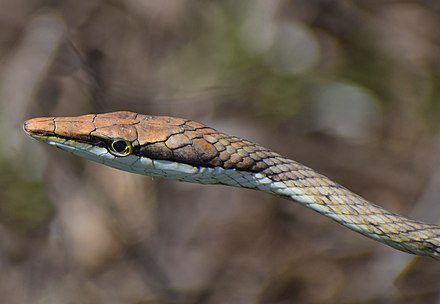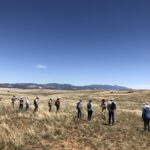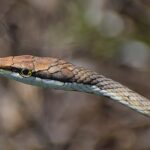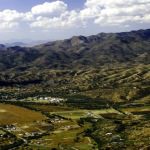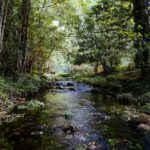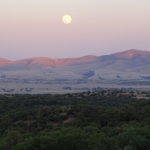Common Names: Brown Vinesnake, Neotropical Vinesnake, Thornscrub Vinesnake, Mexican Vinesnake
Scientific Name: Oxybelis aeneus
Range: From extreme south-central AZ (Patagonia, Atascosas, & Pajarito Mountains) through Mexico and Central America to Peru and Brazil
Description: A long, thin, and vine-like snake with a narrow, triangular head housing vertical pupils. Dorsal color is light brown.
Natural History: The Sky Islands are replete with diverse and engaging species, where biodiversity takes center stage like no other place in the U.S. Some plants and wildlife are obvious and easy to find, even to the casual observer. Not so this unique snake. Don’t expect to waltz into the mountains and encounter this reclusive species, despite its mostly diurnal proclivities. Confirmed only from the our Patagonia, Atascosas, and Pajarito Mountains, this thin reptile indeed looks so much like a vine and is rare enough that you likely will never see one in the wild. The term “ghost species” is then a fitting appellation. There are unconfirmed rumors of the species’ occurance within the Baboquivari and Santa Rita Mountains as well, lending a further mystique. Nevertheless, having the chance to spot a Vinesnake is exciting – somewhat akin to encountering a Mountain Lion or any number of other hard-to-find species inhabiting the Madrean Archipelago. Cold temperatures seem the main limiting factor influencing the distribution of Brown Vinesnakes within the tiny U.S. portion of their range, where they often retreat to tree and rock hollow hibernaculums in winter. In Arizona Brown Vinesnakes inhabit Madrean Evergreen Woodland, Mesquite Woodlands, Tropical Thornscrub, and heavily wooded canyons. There they live a mostly arboreal existence in trees and shrubs, while in searching for prey and seeking to avoid predators.
With a maximum length of about 5 feet (most of which is tail) and a long triangular head, Brown Vinesnakes are unmistakeable. From elevated perches, they keep their eyes peeled for a range of small prey, though especially lizards. In fact, their venom – delivered by enlarged and grooved rear fangs – though mild to humans, swiftly subdues various lizard species. Prey is often stalked with a hypnotic, swaying motion, mimicing a wind-driven vine and allowing the snake to within striking range. Ornate Tree Lizards, Clark’s Spiny Lizards, small birds, small mammals, frogs, insects, and various vertebrate eggs are included in their overall diverse diet. Certain prey items are even enticed to within their deadly grasp via the snake’s wiggling tongue, which seems to pass for a tasty invertebrate treat – a lingual lure, employed by some other reptiles around the globe.
On the flip side of the coin, Vinesnakes are preyed upon by Gray Hawks (somewhat reptile specialists, themselves), other raptors, quite possibly larger snake species, and likely some mammalian predators. When threatened, they can release foul-smelling excretions from their cloaca and gape their black-lined mouth to help ward off danger. After mating, the female lays 3 – 8 eggs within leaf litter in summer, with hatchlings entering the scene from July to September. Brown Vinesnakes face a number of perils, not the least of which is the lack of data on their abundance and even exact range in the Sky Islands. Habitat destruction by mining activity, human developments, roadkills, habitat degradation by overgrazing livestock, and large fires associated with global warming all pose ongoing risks to this retiring species. This is the conservation poster child species for remembering that out of sight should never mean out of mind.
If you think you’ve encountered a Brown Vinesnake in the field, then please take photographs and contact PARA as soon as possible, so that we can document their presence in the region.
Please donate to PARA to support our mission and ongoing quest to protect this and other key species in the Patagonia Mountains, Sonoita Creek Watershed, and beyond. This will help to ensure the conservation of our unique Sky Islands biodiversity for generations to come.
Vincent Pinto is a Wildlife Biologist, Naturalist, Ethnobotanist, and PARA Board Member.

